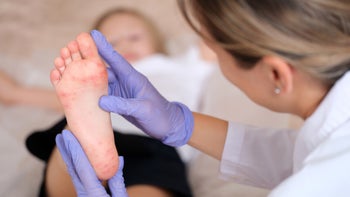
How to Break a Fever: Ways to Bring Temperature Down and How to Know If You Should
Key takeaways:
Fevers are often caused by an infection in the body and can be uncomfortable.
There’s commonly an underlying illness causing a fever, but a fever itself is not usually harmful. And there can even be some benefits to fever.
Over-the-counter medications used to break a fever can make you feel better. But they won’t cure the illness that caused the fever in the first place.
Access savings on related medications
Table of contents

It can feel uncomfortable or even painful to have a fever. When you’re sick and your body temperature rises, you might flip between feeling hot and feeling cold — and between shivering and sweating — at a moment’s notice.
So, what should you do when you have a fever? Should you try to break it, or put up with the discomfort? It turns out that while a fever can be an important sign of illness, it isn’t usually a problem on its own. Wondering how to get rid of a fever? Let’s review the best ways to break a fever — and whether you should do it.
What is a fever?
A fever is when you have an elevated core body temperature above its typical range. The normal human body temperature is about 98.6°F, but can vary slightly throughout the day. In general, a fever can be described by how high the core body temperature rises.
Low-grade fever: 99.1°F to 100.4°F
Moderate-grade fever: 100.6°F to 102.2°F
High-grade fever: 102.4°F to 105.8°F
A fever is usually caused by inflammation in your body. Typically, the inflammation comes from an infection, like the flu or strep throat. But immune-related conditions, cancer, and even some medications can cause a fever, too.
When there’s a lot of inflammation in your body, your immune system releases chemicals that turn up the set-point of your internal thermostat. This makes your body act in certain ways to make itself warmer. For example, a fever causes you to shiver with chills because your body is trying to warm itself up — even though you’re not actually cold.
Over-the-counter (OTC) fever reducers work by interrupting the chemical signals that connect inflammation in your body to your internal thermostat.
Fever medication for children: Find out which fever reducers are best for kids.
Is a fever an emergency? Here are the signs of fever that let you know to get emergency care.
Should you ‘starve a fever’ or ‘feed a fever’? Let’s review the myths and find out how best to treat a fever when you have a cold.
How to break a fever
There are a few different remedies to break a fever, and it’s common to use a combination of treatments. Let’s review common ways you could try to bring a fever down.
Fluids
The first step for fever treatment is to increase the amount of fluids you drink. Having a fever makes it more likely that you can become dehydrated. Drinking plenty of fluids when you have a fever helps make sure that doesn’t happen. Drinking cool fluids can also help bring your temperature down.
Rest
Resting is also important to help keep you cool when you have a fever. When you are active, your body temperature rises. Resting helps keep your body temperature low. Also, because a fever usually means you have an infection, resting can help your body have the energy it needs to fight your infection. There’s also some evidence that not having adequate sleep may cause your infection to worsen.
OTC fever reducers
Medications are often used to fight fever as well. Medications that stop or break a fever are called antipyretics. Common fever reducers are available OTC without a prescription. You’ll want to talk with a healthcare professional for guidance on which medications are best to try.
OTC antipyretics include:
Acetaminophen (Tylenol)
Ibuprofen (Advil or Motrin)
Naproxen (Aleve)
Acetaminophen and ibuprofen can be safely used in infants, children, and adults. But it’s important to know that aspirin should never be used in children, since it has been linked to a dangerous illness called Reye’s syndrome. Naproxen should also be avoided in children until age 12 — it just hasn’t been studied as much in kids.
Home remedies to break a fever
Many people try to treat fevers by cooling the outside of the body. They might try:
Giving a sponge bath
Taking a cool shower
Removing warm clothing or blankets
But cooling the outside of the body isn’t always a good idea. While it might bring the measured temperature down slightly, surface cooling doesn’t affect the temperature deep inside the body (the core temperature). In fact, this can cause the core temperature to rise even higher in response, which can make shivering worse.
What’s the best fever reducer for adults?
All of the OTC fever reducers do a great job at breaking a fever. These fever treatments include:
Aspirin
Acetaminophen (Tylenol)
Ibuprofen (Advil or Motrin)
Naproxen (Aleve)
Since they all work well, you may be wondering what to take for a fever? The best fever reducer for you will depend on a number of factors, such as:
Age
Medical history
Personal preferences
People over the age of 65 or at high risk for kidney injury should avoid ibuprofen and naproxen. At high doses or when taken for long periods of time, these medications can cause kidney damage. Acetaminophen (Tylenol) for fever may be a better choice under these circumstances. But people who drink alcohol daily or have liver issues, should avoid acetaminophen. It can cause dangerous liver damage in some people.
If you don’t like taking medication multiple times per day, you may prefer naproxen over ibuprofen. Naproxen only needs to be taken twice a day, while ibuprofen is dosed 4 times a day.
A healthcare professional can help you figure out the best medication to take to break your fever and limit your risk of complications.
How long does it take for a fever to break?
In general, most OTC fever reducers, like ibuprofen, begin to act within 30 minutes. That doesn’t necessarily mean your fever will break in that amount of time though. How fast your fever will break will depend on the reason for your fever and how high your temperature has gotten.
If your temperature isn’t too high, it’s possible that your fever could break 30 to 60 minutes after taking OTC fever medication. But if you’re very sick with a high fever, it’s possible that your fever doesn’t break even an hour or two after taking fever reducers.
Some people can take multiple fever reducers when it’s taking a long time for a fever to break. It’s common to take acetaminophen and a nonsteroidal anti-inflammatory drug (NSAID), like ibuprofen, at the same time to break a fever fast. These medications work in different ways, so it’s generally safe to take them together.
It can also help to space the medications apart by a couple of hours when trying to break a fever. Many people do this to take a second medication before the first one starts to wear off. Both of these strategies make sense and you can choose which one works better for you.
But be careful not to take multiple NSAIDs together to break a fever. It’s not safe to take ibuprofen, naproxen, or aspirin together. It can cause severe health complications and stomach issues, including bleeding.
Should you break a fever?
It’s natural to want your fever to go away. But treating a fever doesn’t stop the infection that caused it — all it does is bring your temperature down. Even so, you might want to break your fever because:
A fever can make you feel low.
An extremely high fever (105°F or above) can cause damage to the body.
A fever can cause dehydration.
Fevers can make some people more likely to get a febrile seizure.
Does a fever have any benefits?
It seems likely that fevers happen for a biological reason. It’s not entirely clear why, but here’s what scientists have learned so far:
Some germs, including the virus that causes COVID-19, slow down their growth when the temperature around them rises.
Our immune system is more efficient when our body temperature is higher.
A fever can weed out weak body cells — such as those damaged by an infection — and this might lower the amount of time you feel sick.
Aside from these natural benefits, fevers are helpful from a practical standpoint because:
The pattern of your fever can give clues about the illness that might be causing it. It can help you track whether your infection is getting better or worse.
Many modern antibiotics actually work better at warmer temperatures.
What should I do if I have a fever?
While a fever isn’t always harmful, you still shouldn’t ignore it. Most times, a fever is caused by an infection, and some infections can be serious. In general, it’s best to stay home. Your infection could be contagious to others.
There can be times when a fever requires medical attention. See a healthcare professional right away if:
An infant younger than 3 months has a fever over 100.3°F.
An infant 3 to 12 months old has a fever above 102.2°F.
A child has a fever, and is unvaccinated.
You have a very high fever (105°F or higher).
You’ve had a fever for more than 3 days in a row.
You have a fever plus other symptoms, like weight loss, rash, cough, or difficulty breathing, that you can’t explain.
You’ve recently had surgery.
You have a fever and are immunosuppressed, have an immune deficiency, or are receiving chemotherapy.
You have an IV line, such as a PICC line, port, or central venous catheter.
You take drugs recreationally through an IV.
The bottom line
Whether you choose to break a fever is up to you. While a fever can make you feel low, there might be good reasons to let a fever run its course. If you do choose to break your fever, antipyretic medications are effective. But remember, they won’t treat the underlying cause.
While medication can help lower your temperature and relieve symptoms, it’s important to know when to get medical attention. A healthcare professional can identify and treat the illness that may be causing your fever, and prevent further complications.
Why trust our experts?



References
Balli, S., et al. (2023). Physiology, fever. StatPearls.
Belon, L., et al. (2021). Effect of a fever in viral infections - The 'Goldilocks' phenomenon? World Journal of Clinical Cases.
Evans, S. S., et al. (2015). Fever and the thermal regulation of immunity: The immune system feels the heat. Nature Reviews Immunology.
Garbarino, S., et al. (2021). Role of sleep deprivation in immune-related disease risk and outcomes. Communications Biology.
Hajdu, S., et al. (2010). Increased temperature enhances the antimicrobial effects of daptomycin, vancomycin, tigecycline, fosfomycin, and cefamandole on staphylococcal biofilms. Antimicrobial Agents and Chemotherapy.
Healthychildren.org. (2022). Treating your child’s fever. American Academy of Pediatrics.
LeWine, H. E. (2023). Fever in adults: When to worry. Harvard Health Publishing.
MedlinePlus. (2022). Fever.
Meremikwu, M., et al. (2003). Physical methods versus drug placebo or no treatment for treating fever in children. The Cochrane Database of Systematic Reviews.
Walter, E. J., et al. (2016). The pathophysiological basis and consequences of fever. Critical Care.
Wrotek, S., et al. (2021). Let fever do its job: The meaning of fever in the pandemic era. Evolution, Medicine, and Public Health.




















